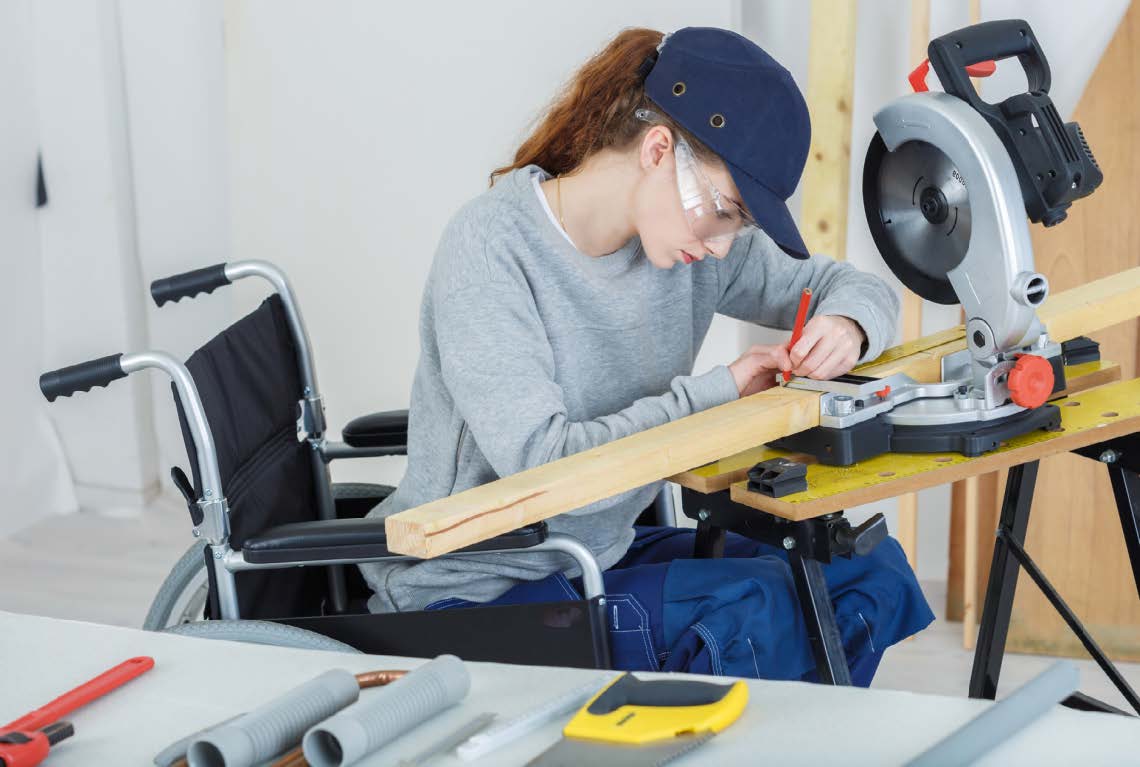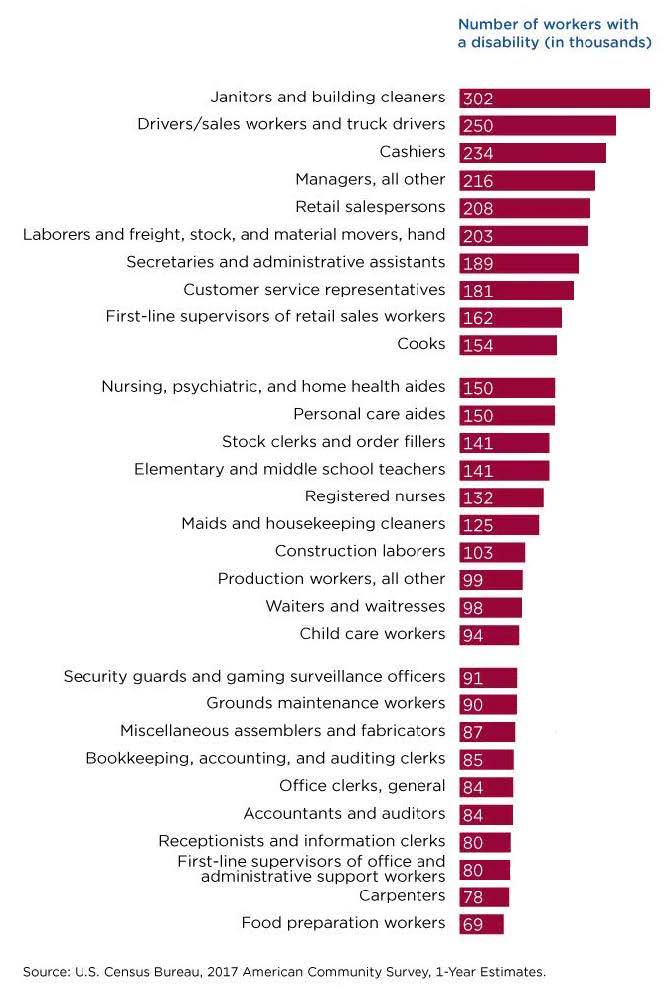AMERICAN ACADEMY OF DEVELOPMENTAL MEDICINE & DENTISTRY
My teenager has a disability - will he/she find employment after high school or college?
BY H. BARRY WALDMAN, DDS, MPH, PHD, JEFFREY SEIVER, DDS AND STEVEN P. PERLMAN, DDS, MSCD, DHL (HON)
"In 2018, the employment-population ratio – the proportion of the population that is employed – was 19.1 percent among those with a disability, the U.S. Bureau of Labor Statistics reported today. In contrast, the employment-population ratio for those without a disability was 65.9 percent." 1
DO PEOPLE WITH DISABILITIES EARN EQUAL PAY?
"Today, a record 9 million people with a disability work. While these workers, age 16 and older, are spread throughout the labor force, workers with a disability tend to concentrate in certain jobs depending on their age and particular disability." 2
The U.S. Census Bureau reported for the year 2017, that overall, workers with a disability earn less than workers who do not have a disability. As a group, full-time, year-round workers with a disability earn 87 cents for every dollar earned by those with no disability. However, among people working similar jobs and schedules, the median earnings for workers with a disability are either very close to, or not different from, earnings for workers with no disability. In fact, accounting for the differential mix of occupations between these workers with or without a disability reduces the overall disparity in median earnings by about half. 2,3
A few occupations stand out as exceptions, with notable differences in median earnings between the two groups. These occupations typically have much higher median earnings for people both with a disability and with no disability. These include:
- • Chief executives
- • Lawyers
- • Marketing and sales managers
- • Financial analysts.
However, the median earnings for physicians and surgeons, who rank at the top of the earnings list, are no different between those with a disability and those without.
OCCUPATION
The most common occupations for people with a disability are janitors and building cleaners, where about 300,000 workers with disabilities find employment. They make up 11 percent of workers in this occupation. Other large occupations for workers with disabilities are:
- • Drivers/sales workers/truck drivers
- • Cashiers
- • Retail salespersons
- • Laborers and freight, stock and material movers. (See chart 1)
AMERICAN ACADEMY OF DEVELOPMENTAL MEDICINE AND DENTISTRY
The American Academy of Developmental Medicine and Dentistry (AADMD) was organized in 2002 to provide a forum for healthcare professionals who provide clinical care to people with neurodevelopmental disorders and intellectual disabilities (ND/ID). The mission of the organization is to improve the quality and assure the parity of healthcare for individuals with neurodevelopmental disorders and intellectual disabilities throughout the lifespan.
Workers with disabilities increase with age
Workers with disabilities increase with age Workers with a disability make up just 6 percent of working adults, but this figure rises with age. About 4 percent of workers under age 45, 7 percent of workers ages 45-59, and 13 percent of workers age 60 and older have a disability.
- Top-ranked occupations for younger workers (ages 16 to 44) with a disability are:
- • Cashiers
- • Laborers/freight/ stock/material movers-hand
- • Janitors and building cleaners
- • Customer service representatives
- • Cooks
- • Retail salespersons
- • Stock clerks/order fillers
- • Waiters/waitresses. 2,3
BY TYPE OF DISABILITY
Ambulatory, hearing and cognitive disabilities are the most common difficulties among workers with a disability, which may have an impact on the type of jobs they can get. For younger workers with a disability, cognitive difficulty is the most common, while ambulatory and hearing difficulties are more common among older workers. In fact, about half of working-age adults with a disability reported they had a health condition that was an impediment for the kinds of work they could perform or the number of hours they could work. This varies by disability type. People with a hearing disability are more likely to work than people with other disability types. 2,3
Highest and lowest employment rates for workers with disabilities by state (2016)
There is a wide range of employment rates for workers with disabilities in the individual states; ranging from 25.4% in West Virginia to 57.1% in Wyoming. 4
- 1. Wyoming . . . . . .57.1%
- 2. South Dakota . . .51.7
- 3. North Dakota . . .48.8
- 4. Nebraska . . . . . . .48.6
- 5. Minnesota . . . . . .47.5
- 46. South Carolina . . . .28.7%
- 47. Alabama . . . . . . . . .27.9
- 48. Mississippi . . . . . . .27.5
- 49. Kentucky . . . . . . . .27.4
- 50. West Virginia . . . . .25.4
AMERICANS WITH DISABILITIES ACT OF 1990 (ADA)
If your teenager is seeking a job or is new to the workforce, as a parent you should become familiar with ADA, a federal civil rights law designed to prevent discrimination and enable individuals with disabilities to participate fully in all aspects of society. One fundamental principle of the ADA is that individuals with disabilities who want to work and are qualified to work must have equal opportunity to work.
To be protected, your teenager must be a qualified individual with a disability. This means that he/she must have a disability as defined by the ADA. Under the ADA, you have a disability if you have a physical or mental impairment that substantially limits a major life activity such as hearing, seeing, speaking, thinking, walking, breathing, or performing manual tasks. Your teenager also must be able to do the desired job he/she wants or was hired to do, with or without reason able accommodation. A reasonable accommodation is any change or adjustment to a job, the work environment, or the way things usually are done that would allow your teenager to apply for a job, perform job functions, or enjoy equal access to benefits available to other individuals in the workplace.
You or teenager simply must let the employer know that the youngster needs an adjustment or change because of the disability. There are no special forms or use of technical language to do this. For example, if a wheelchair is needed and it does not fit under your desk at work, all that is needed is to inform the supervisor. This is a request for a reasonable accommodation. A doctor's note requesting time off due to a disability or stating that your teenager can work with certain restrictions is also a request for a reasonable accommodation. (See reference 5 for more details in the Guide for People with Disabilities Seeking Employment)
PREPARING YOUR TEENAGER WITH A DISABILITY FOR EMPLOYMENT
"One of the most important parts of transition planning is ensuring that a youth with disabilities should learn to advocate for themselves and the supports they need. Youths need to understand their rights. As they transition into employment or postsecondary education, they will need to be able to communicate their needs and may need to help identify where they can receive those supports…" 6
The Individual Disability Education Act (IDEA) includes requirements for special education and related services for children and youth until the age of 21. Recognizing the importance of maintaining a continuum of services beyond high school and into adulthood, federal disability legislation requires the inclusion of transition planning in each child's Individualized Education Plan (IEP). By the time a student reaches the age of 16 (if not before), the IEP must include measurable postsecondary goals and identify appropriate transition services.6
Parents "know their children," but so do their health practitioners and service personnel. The need is for input from concerned individuals who realistically can assist and guide your teenager who is transitioning from the difficulties of the teen years to the early stages of adulthood and employment. Now add the complexities of disabilities! •

WORK TO DO: Ambulatory, hearing and cognitive disabilities are the most common difficulties among workers with a disability. For younger workers with a disability, cognitive difficulty is the most common, while ambulatory and hearing difficulties are more common among older workers.

ABOUT THE AUTHORS:
H. Barry Waldman, DDS, MPH, PhD is a SUNY Distinguished Teaching Professor, Department of General Dentistry, Stony Brook University, NY. E-mail: h.waldman@stonybrook.edu Jeffrey Seiver, DDS is a Clinical Assistant Professor, Department of General Dentistry, Stony Brook University, NY. Steven P. Perlman, DDS, MScD, DHL (Hon) is the Global Clinical Director and founder, Special Olympics, Special Smiles and Clinical Professor of Pediatric Dentistry, The Boston University Goldman School of Dental Medicine.
References
- 1. Bureau of Labor Statistics. Persons with a disability. Available from: bls.gov/news.release/pdf/disabl.pdf Accessed March 27, 2019.
- 2. U.S. Census Bureau. Do people with disabilities earn equal pay? Available from: census.gov/library/stories/2019/03/do-people-with-dis- abilities-earn-equalpay.html?utm_campaign=20190320msacos1ccstors&utm_medium=email&utm_source=govdelivery Accessed March 25, 2019.
- 3. Day JC, Taylor D. In most occupations, workers with or without disabilities earn about the same. Available from: census.gov/library/stories/2019/03/do-people-with-dis- abilities-earn-equalpay.html?utm_campaign=20190320msacos1ccstors&utm_medium=email&utm_source=govdelivery Accessed March 25, 2019.
- 4. See how your state ranks in employment among workers with disabilities. Available from: fortune.com/2017/02/28/disability- employment-rank/ Accessed March 26, 2019.
- 5. Social Security Administration. A Guide for People with Disabilities Seeking Employment. Available from: ada.gov/workta.pdf Accessed March 26, 2019.
- 6. Youth.gov. Considerations for youth with disabilities. Available from: youth.gov/youth-topics/youth-employment/employment- considerations-for-youth-with-disabilities Accessed March 26, 2019.